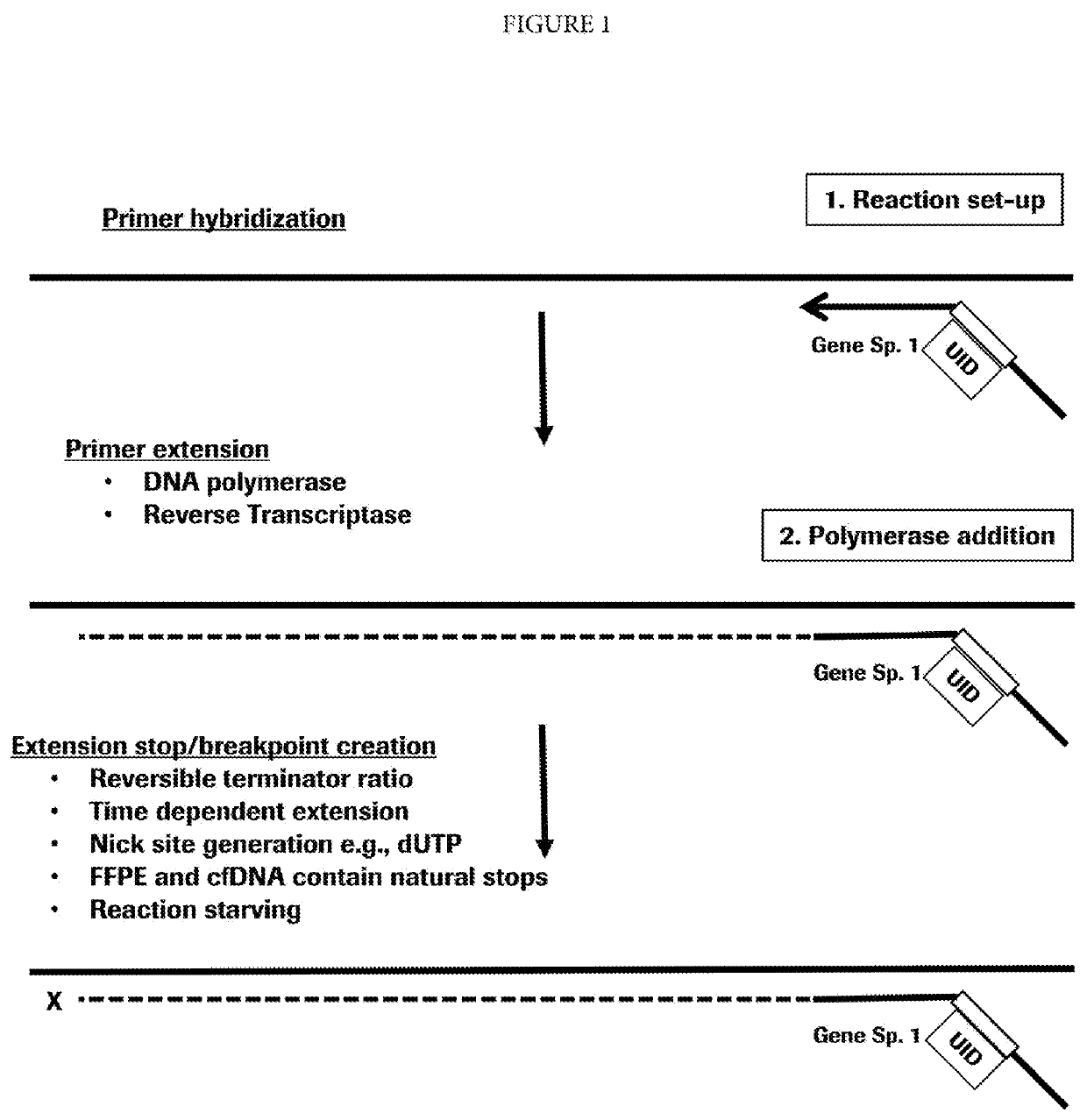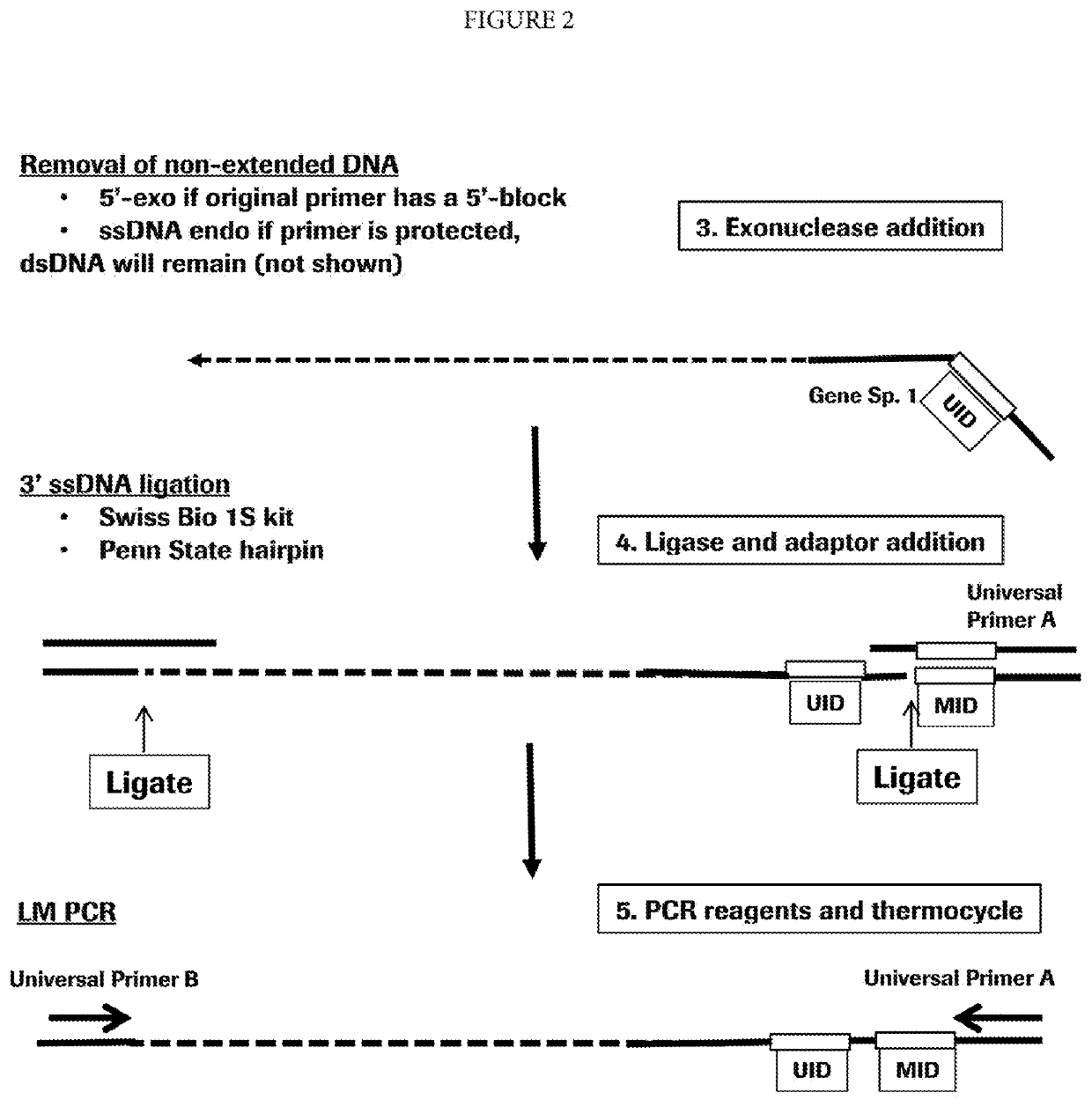Target enrichment by single probe primer extension
a single probe and primer technology, applied in the field of enrichment of nucleic acid targets, can solve the problems of long and complex protocols that tend to take well over 8 hours to complete, dual primer based technologies are not capable of enriching sequences with unknown structural variations, and can amplify tens of targets
- Summary
- Abstract
- Description
- Claims
- Application Information
AI Technical Summary
Benefits of technology
Problems solved by technology
Method used
Image
Examples
example 1 (
Prophetic)
Target Enrichment with Gene-Specific Primer and Linear Amplification
[0054]Nucleic acids are isolated from a human blood plasma sample using DNeasy Blood & Tissue Kit (Qiagen, Valencia, Calif.). A gene-specific primer is added. The primer is designed having a gene-specific portion hybridizing to exon 19 of the human EGFR gene. The primer also has a 6-mer unique identification sequence (UID) and a universal ligation sequence. The primer is modified at the 5′-terminus to prevent exonuclease digestion. The primer is allowed to hybridize in Isothermal Amplification Buffer (New England Biolabs, Ipswich, Mass., “NEB”) at 60° C. for 20 minutes and Bt Polymerase 2.0 (NEB), a non-thermostable DNA polymerase is added and incubated for 20 seconds at 65° C. The reaction is terminated by heat-killing the polymerase at 95° C. for 3 minutes. The template strands of nucleic acid are digested with a combination of the 5′ ssDNA specific exonuclease RecJF (NEB) and the 5′ dsDNA specific lambd...
example 2 (
Prophetic)
Target Enrichment with a Degenerate Primer and Exponential Amplification
[0058]Nucleic acids are isolated from a human blood plasma sample using DNeasy Blood & Tissue Kit (Qiagen, Valencia, Calif.). A primer containing a degenerate sequence is added. The primer is designed having a random sequence of six nucleotides, a 6-mer unique identification sequence (UID) and a universal ligation sequence. The primer is modified at the 5′-terminus to present exonuclease digestion. The primer is allowed to hybridize is in Isothermal Amplification Buffer (NEB) at 60° C. for 20 minutes and Bst Polymerase 2.0 (NEB), a non-thermostable DNA polymerase is added and incubated for 20 seconds at 65° C. The reaction is terminated by heat killing the polymerase at 95° C. for 3 minutes. The template strands of nucleic acid are digested with a combination of the 5 ssDNA specific exonuclease RecJF (NEB) and the 5′ dsDNA specific lambda exonuclease. The non-extended primers are removed using Ampure b...
PUM
| Property | Measurement | Unit |
|---|---|---|
| melting temperature | aaaaa | aaaaa |
| temperature | aaaaa | aaaaa |
| length | aaaaa | aaaaa |
Abstract
Description
Claims
Application Information
 Login to View More
Login to View More - R&D
- Intellectual Property
- Life Sciences
- Materials
- Tech Scout
- Unparalleled Data Quality
- Higher Quality Content
- 60% Fewer Hallucinations
Browse by: Latest US Patents, China's latest patents, Technical Efficacy Thesaurus, Application Domain, Technology Topic, Popular Technical Reports.
© 2025 PatSnap. All rights reserved.Legal|Privacy policy|Modern Slavery Act Transparency Statement|Sitemap|About US| Contact US: help@patsnap.com


